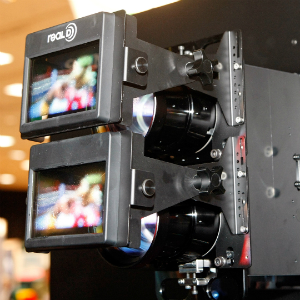As for actually “doing it”, “it” is obscure, and in the past has required expensive equipment for those specifically trained techs, and – oh yes – enough of a perceived need that the potential do-ers get enough incentive that it gets done. And, once done, what do you do with the data? Who can get to it who is trained to understand it and do something about it? really cares?
In that vein, Harkness announced for CineAsia that they have made their affordable and well-crafted iPhone tool – The Digital Screen Verifier – even more affordable. The price was dropped 25%…and considering it was only $40 to start with, that kicks the price into stocking stuffer range. Here’s the iTunes store link, and after the video are a few more comments and a few complaints.
iTunes page for Digital Screen Verifier By Harkness Screens Ltd
(The Digital Screen Archiver mentioned in the video is at: iTunes page for Digital Screen Archiver by Harkness Screens
Once again, behind all the joy and sparklers for the incredible laser and immersive sound variations, we are reminded that we live in a world where the weakest link can be the most important part of an equation. So, with the noise of one more convention gone perhaps the noise we hear is the sound of constant SMPTE meetings dealing with the dozens of topics that make the interlocking concerns of sound and light and pipeline and workflow and security nuance work together.
But that is the few who have the time (often corporate supported) and (often personally inspired) desire to put their hard won talent and experience into group cooperation mode to grind out usable and mutually beneficial documents. Viewers benefit, small companies can benefit from the more stable environment and not coincidently, large corporations advance their causes as well.
At the user end of the Director’s Intent is image and sound that the average moviegoer pays 9 or 12 or 18 or 36 money units and their time units for. Do they get an image that is correctly white balanced from a center at 48 candela/square meter and is between 85 and 90 percent at the edges and corners? With all the high gain and silver screens out there, one can guarantee that this is impossible.
But light levels should be/can be the best that they can be. But given that projectors largely compensate for that by changing the amperage as the bulb’s darkness magnet loses its absorption capability, is it needed?
Here’s one argument. A tech puts in the new bulb and sets up the projector correctly and goes to the next task. We know from the bulb manufacture’s specs that it loses 15% of its power in the first 100 hours then stabilizes into a much less steep slide to death. Contrary to the bulbs of 15 years ago, the balance of red and green and blue stays pretty tight instead of losing blue (thus displaying brown).
But who cares and is the problem big enough that more people should care?
Exhibitors care to the degree that they have gone to the great effort of coining a general phrase (and 3 letter acronym) and adapting hundreds of theaters to be Premium Large Format – PLFs. Give or take a few, of the 130 thousand movie auditoriums there are 1,000 IMAX rooms. Many theater chains have copied parts of the IMAX boutique model with their own TLAs and secret sauce combinations …usually full width, full height screens, an upgraded sound system and cool seats. Each chain then uses a different three letter acronym, which costs nothing. But the extra equipment and installing the extra equipment costs a bundle.
Dolby has offered these facilities a complete Dolby Cinema solution that carries their super Dolby Vision projectors and Dolby Atmos audio systems along with a room design that can handle the widened contrast window and the discerning client’s eyes and ears. AMC is converting their “AMC Prime” rooms to be Dolby Cinema with AMC Prime rooms. They are keeping their IMAX rooms and the rooms with RealD, giving customers a lot of choice, except the choice to have the best 3D possible which would be in the Dolby Cinema at AMC Prime room.
[Side Note: The last time I attended a movie in a Dolby Cinema room many of us stayed behind and got to watch as the complete picture system was re-tweaked between shows. Geek heaven for the colorists and learners among us and much more interesting than watching the automated process that the IMAX systems are put through daily. There are other cinema chains in the vicinity which have a member of staff announce before each show that the picture and audio was checked recently for our viewing pleasure. What tests they run isn’t mentioned and probably we’re better off not knowing since we’d definitely stay more impressed with the magic than the actual doing. [Side Note Ends.]
Point being that there is an acknowledgement that there is room for more better…which implies an acknowledgement that the majority of those 130,000 rooms need more something. There are just so many understandable compromises when building and outfitting a room that
The Digital Screen Verifier is a tool that a cinema theater manager can use every day, checking a few auditoriums each day so that every room is checked once every week using a Walk Though Checklist that a non-technical person can follow.



